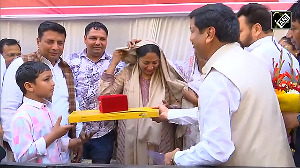The deceleration will be on account of the industrial slowdown during the quarter, the economists said. Numbers collated by the Central Statistical Organisation show that industrial output grew 4.9 per cent during July-September 2008, down from 9.5 per cent in the same quarter last year. Industry accounts for 26 per cent of the country's gross domestic product, the sum total of the goods and services produced in a year.
To combat high commodity prices (farm products, metals as well as crude oil), the Reserve Bank of India (RBI) raised its key rates without pause till recently in order to tighten the money supply. To make matters worse, state-owned oil marketing companies sucked out a lot of liquidity as they had to sell petrol, diesel and LPG at prices much below cost.
"There is a sharp industrial slowdown in the second quarter. It (industry growth rate) has almost halved from last year's level of around 10 per cent," said DK Joshi, economist with Crisil Ltd, a ratings and advisory firm.
Most economists agreed that the silver lining for the quarterly numbers will be provided by agriculture and services. The services sector, which accounts for more than half of the country's output, is expected to grow in excess of 9 per cent in the second quarter, as certain sectors like telecom are continuing to attract record additional subscribers.
The farm sector too has recorded better than expected growth, though its contribution to the country's GDP has shrunk to 17 per cent. YES Bank chief economist Shubhada Rao said, "Services and agriculture sectors' growth will compensate for slow growth in industry."
On Tuesday, the government revised upwards the earlier kharif crop estimate. Also, the rabi sowing area has increased compared to last year, said Agriculture Secretary T Nand Kumar, without spelling out the numbers. "We expect a better kharif season. The grain output in the period is likely to be better than earlier projections," said HDFC Bank chief economist Abheek Barua.
The slowdown in growth is expected to drastically reduce private sector investment, which was cited as a main reason for India to achieve 9 per cent plus growth rate in the last three years up to March 2009. Investment rate, expressed as a per cent of GDP, increased by more than 10 percentage points to touch 35.9 per cent in 2008-09.
This is partly the reason why the government is keen to promote public financing to keep the investment momentum going. The Planning Commission, India's apex planning body, is preparing a list of infrastructure projects which can be funded directly by the government through the budget or by way of state-run financial institutions.
Analysts and economists alike expect the real pain of the global meltdown to show up in the third quarter (October-December 2008) numbers. This was the period when several industrial units cut back on production and exports took a beating. The commerce ministry has, in fact, now said that the export target of $200 billion for the current financial year, up from $160 last year, now looks difficult.Global meltdown: Complete coverage







 © 2025
© 2025